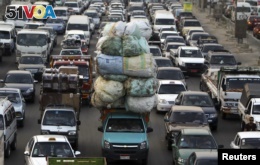January 04, 2013
Every year, road crashes kill more than a million people around the world and injure many, many more. But a new study says deaths and injuries can be sharply reduced by taking simple safety measures. What’s more, safer roads can bring major economic benefits as well.
Dr. Margie Peden said that traffic collisions should be viewed as a health issue.
“It’s a huge public health problem. It’s a public health problem
akin to those of malaria, tuberculosis and some other infectious diseases. It kills around 1.3 million people every year and it injures and disables somewhere between 20 and 50 million people,” she said.

A traffic jam, one of five key issues Egyptian President Mohamed Mursi outlined in his Al Nhada (Renaissance) project, is pictured in old Cairo October 8, 2012, a day after his 100th day in power.
Peden is coordinator for Unintentional Injury Prevention at the World Health Organization.
“I liken it to a disease because it’s often not thought of as a public health issue. Very often in countries it’s thought of as a transport issue only. Although some of the issues around prevention may be related to improving vehicles or improving the road, lots of the patients obviously end up in hospitals and they consume huge amounts of resources,” she said.
She was asked to review the study, which appears in the Bulletin of the World Health Organization.
The study describes safety measures taken between 2000 and 2010 in Catalonia, Spain, the far northeastern region that borders France.
“We were very aware that during these 10 years, from 2000 to 2010, there was an important decrease in the number of traffic crashes and deaths. So we thought, ok, just to make it more impressive and understandable for anybody, let’s translate this figure into economic terms. So people [are] aware of the money that could be saved using public health measures,” said Health economist Dr. Anna Garcia-Altes, who’s the lead author.
Dr. Garcia-Altes, who works for the Catalan Agency for Health Information, Assessment and Quality in Barcelona, outlined the economic benefits of road safety in Catalonia.
“First, if people [are] less injured they go less to the hospital, right? So there’s an immediate impact because people don’t use the emergency room, hospital admissions, rehabilitation, long-term care, etcetera. The second thing is if people [are] not injured they can go to work. And finally we were estimating that in this 10-year period there were 3000 less deaths due to car accidents. So this has also an economic impact,” she said.
The safety measures that were strictly enforced include seatbelt usage, speed limits, drunk driving laws and a penalty point system for repeat offenders that could result in the loss of drivers’ licenses.
Dr. Garcia-Altes said that she’s been contacted by European and U.N. officials, who are interested in the safety program.
WHO’s Dr. Margie Peden described the Spanish study as “an important piece of work, as there are few economic evaluations of road safety policies.”
She said that poor data collection makes it difficult to have an official list of regions where road traffic deaths are the worst. Nevertheless, the information that is available indicates North Africa, sub-Saharan Africa and the eastern Mediterranean regions fall into that category.
Peden said that there needs to be new thinking about road safety.
“Unfortunately, for many, many years road builders have really only thought about the car occupants and not the person outside the car. And if we look at road users globally we see that nearly 50 percent of them are actually what we call vulnerable road users. These are people that are outside the vehicle, like pedestrians or cyclists or motorcyclists,” she said.
The World Health Organization official would rather not use the word “accident” in safe driving campaigns.
She said, “The term ‘accident’ conjures up in people’s minds that this is an act of God, a fate. Something that is not preventable.”
She prefers the terms “road traffic collisions” or “road traffic crashes.”
Much attention is now being paid to “distracted driving.” One example of this is sending text messages over mobile phones while driving.
“If we look at the statistics around the world, there are a few highly sensationalized accounts of deaths related to texting. But when you actually look at the numbers you will find that there are actually very few deaths related specifically to texting, but there’s lots of minor collisions, fender benders, what they call lane deviations or people driving slowly because they’re trying to text while their driving with their knees or something,” she said.
She said that distracted driving is a problem, but recommends dealing with speeding, drinking and driving, not wearing seatbelts or helmets first.
We are currently in the early years of the U.N.-designated Decade of Action for Road Safety. Peden says it has the ambitious goal of trying to reduce by half the number of road traffic crashes. It may be an uphill battle. Road traffic crashes are currently predicted to rise during that time from the ninth to the fifth leading cause of death in the world.